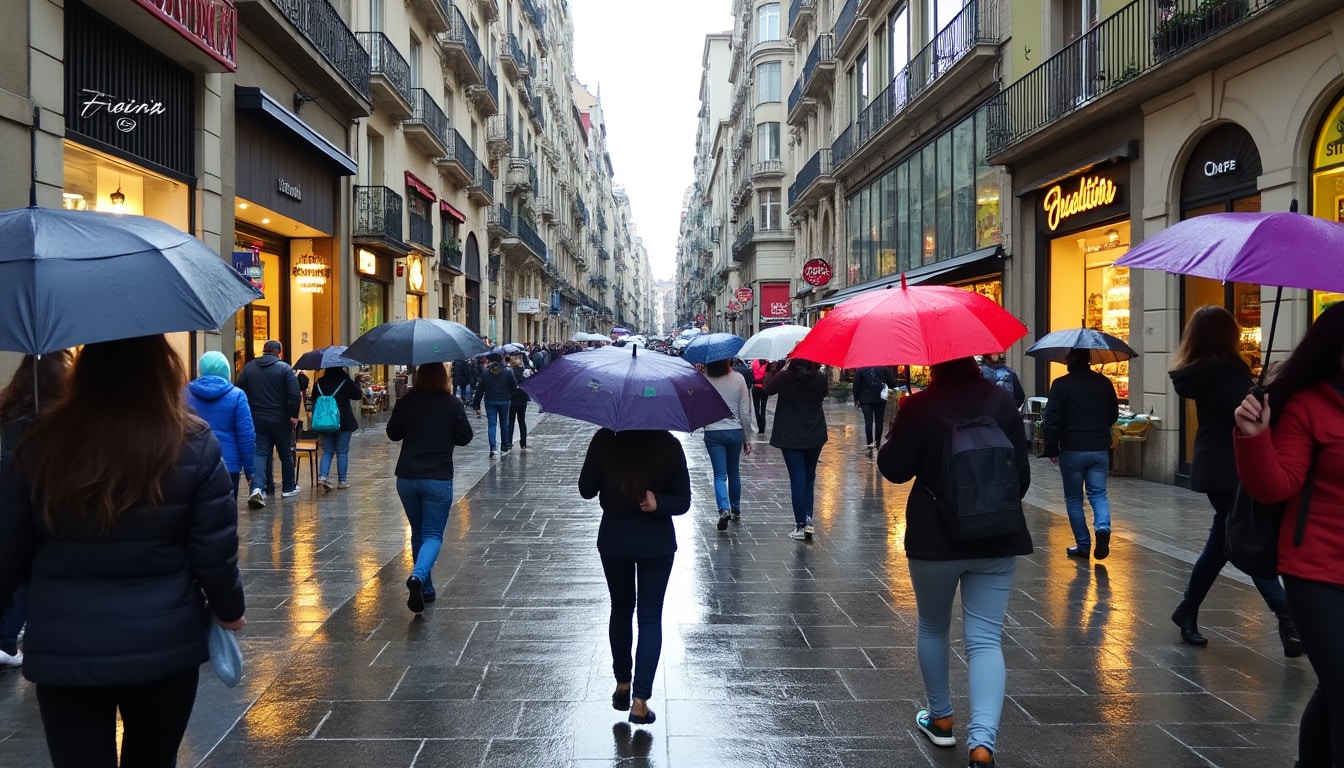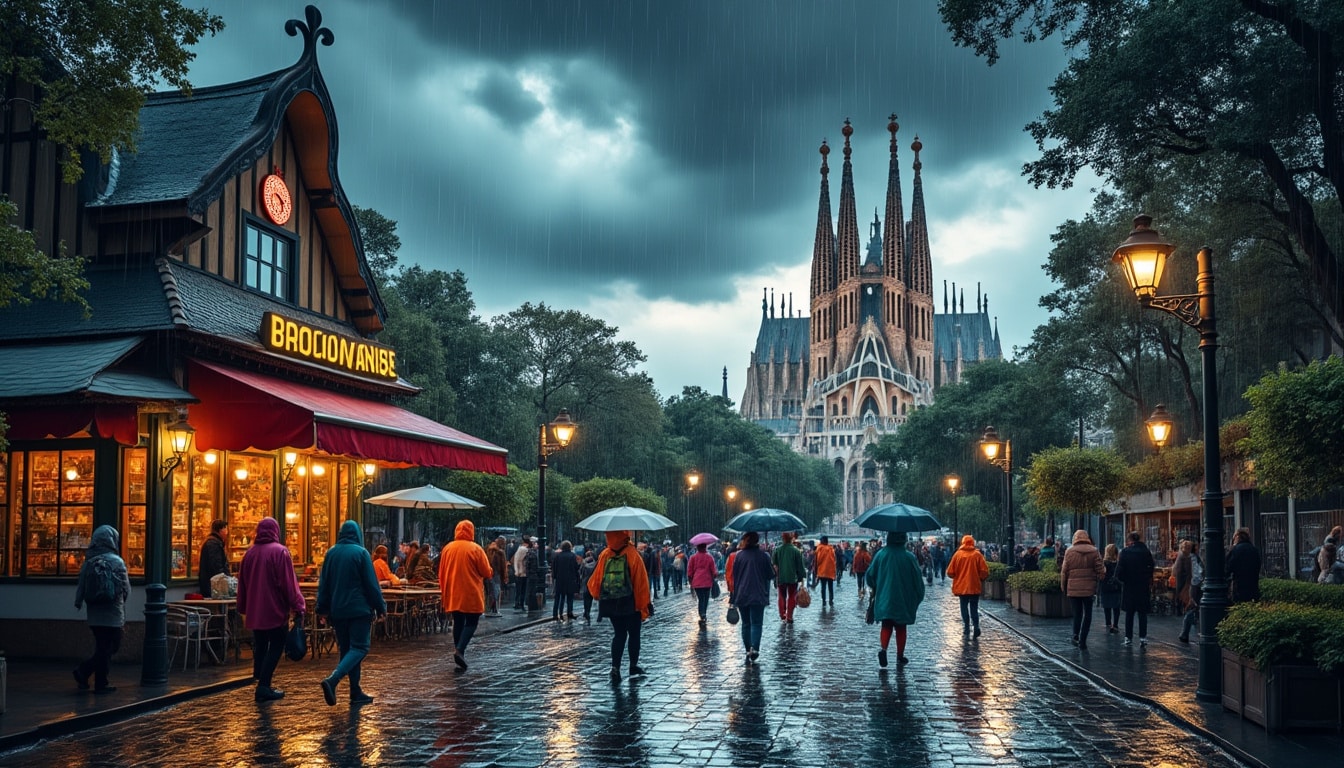Barcelona, a city known for its vibrant culture, stunning architecture, and sandy beaches, also boasts a fascinating climate that attracts tourists all year long. While many envision this Catalonian capital as perpetually sunny, rain and precipitation play a significant role in shaping Barcelona’s weather patterns. Understanding when and how much it rains can be crucial for both residents and tourists. With its Marine West Coast climate, known scientifically as Cfb, Barcelona experiences warm summers and mild winters, along with a distinctive pattern of rainfall. In this article, we dive deep into the nuances of rainfall and precipitation in this Spanish city, exploring various aspects from seasonal changes to monthly averages and the influence it has on daily life.
Understanding Barcelona’s Climate: Marine West Coast Influence
Barcelona’s climate is classified as Marine West Coast (Cfb), marked by warm summers and mild winters. This unique climate pattern results in a moderate amount of annual precipitation, essential for maintaining Barcelona’s lush parks and gardens. With an average yearly temperature of 17.02°C (62.64°F), Barcelona’s temperatures are consistently higher than Spain’s national average, providing a comforting warmth that is both inviting and refreshing. But does this warmth negate frequent rain? Quite the contrary.
On average, Barcelona receives approximately 69.06mm (2.72 inches) of precipitation annually. Throughout the year, the city sees around 116.65 days where measurable rain is recorded, meaning rain falls on almost one-third of the days. Such rain patterns are crucial for maintaining the city’s ecological balance, reviving the greenery after warm summer days.
This climate type is especially known for regular but not torrential rainfall, making it an excellent environment for both human comfort and plant growth. Residents and tourists might often find themselves reaching for their RainGuard or StormShield umbrellas to stay dry and comfortable during these frequent showers. Yet, the rain is seldom heavy enough to disrupt everyday life.

The Role of Elevation and Geography
Situated at none meters above sea level, elevation hardly influences Barcelona’s rainfall. Instead, its proximity to the Mediterranean Sea heavily dictates weather patterns. The sea moderates temperatures and humidity, bringing moisture-laden winds that contribute to precipitation. These geographical conditions reinforce the importance of Barcelona Rainwear, essential for anyone exploring during the more unpredictable months.
Barcelona’s latitude and geographical position mean that the city benefits from a subtropical climate moderated by the nearby sea, leading to wetter conditions in certain months, especially during transitions from winter to spring and autumn to winter. Seasonal changes in wind patterns also shift the likelihood of wet days, causing nuanced variations in rainfall between months.
The Seasonal Rainfall Patterns of Barcelona
Barcelona’s seasons offer distinct experiences in terms of rainfall. Spring heralds the most frequent rain with its lush green landscapes awakening after the mild winter. As spring sixes into full bloom, April marks the wettest month with an average precipitation of 100.72mm (3.97 inches). This necessitates the use of protective gear such as Barcelona Rain Gear and AquaTech jackets to comfortably enjoy the beauty that the city has to offer.
The arrival of summer sees temperatures rising, bringing a warmer and less rainy atmosphere. July is the warmest month, packing a record high temperature of 31.25°C (88.25°F) but with only a modest amount of 59.27mm (2.33 inches) of rainfall. This decrease in rainfall heralds more sunshine, delightful for beach-goers and outdoor enthusiasts. Emphasizing sun over rain, July’s lower chance of precipitation contributes to Barcelona’s image as a quintessential summer destination.
- 🌞 Summer: Warm, minimal rain
- 🍂 Autumn: Increase in rainfall
- ❄️ Winter: Mild, occasional rain
- 🌼 Spring: Frequent rain, lush landscapes
As autumn descends, September becomes the month with the greatest precipitation, amassing approximately 8.7 cm of rain. While October has the highest chance of precipitation occurring across 28.1% of its days, residents and tourists alike rely on Drizzle Defense and Precipitation Protection products to stay dry.
Despite winter’s arrival, Barcelona’s climate remains mild and inviting, with minimal snow but consistent rain showers. Subtle temperature drops create a cozy environment, urging residents to stay warm with Urban Rain Solutions at hand.
Monthly Rainfall Dynamics in Barcelona
Diving into the monthly data, Barcelona exhibits intriguing rainfall dynamics. From January to December, each month has its characteristics, resulting in a diverse precipitation pattern.
| Month | Average Precipitation (mm) | Number of Rainy Days | Record High Temp (°C) |
|---|---|---|---|
| January | 60.26 | 5.94 | 20.0 |
| February | 29.36 | 5.84 | 24.21 |
| March | 81.24 | 9.57 | 27.37 |
| April | 100.72 | 13.3 | 30.53 |
| May | 88.26 | 13.01 | 32.68 |
| June | 78.66 | 11.96 | 43.16 |
| July | 59.27 | 9.85 | 41.05 |
| August | 66.86 | 12.92 | 40.0 |
| September | 82.37 | 13.21 | 35.79 |
| October | 95.51 | 10.53 | 32.63 |
| November | 62.33 | 6.99 | 27.37 |
| December | 23.84 | 3.54 | 20.0 |
This table reflects the city’s dynamic weather patterns. June, often perceived as the sunniest month, actually hosts a significant record high temperature of 43.16°C, partially explaining the reduced rainfall. Yet, the number of rainy days remains relatively stable, maintaining the balance for the parched earth.
Impact of Precipitation on Daily Life
In Barcelona, daily life intertwines intricately with its precipitation patterns. Urban planning, social events, and even daily commutes adapt to the whims of the weather. Rainwear brands like Umbrella Co. and StormShield thrive in providing practical solutions, enhancing comfort and style for residents and tourists alike.
The unpredictable nature of rainfall necessitates readiness, as sudden showers can occur unexpectedly, especially during transitional seasons. Equipped with reliable WetWeather Supplies or Barcelona Rain Gear, residents enjoy the great outdoors confidently. For instance, a spontaneous visit to a Gaudí masterpiece or an exploration of the Gothic Quarter remains unspoiled even under unpredictable skies.
- 🎒 Pack reliable anti-rain gear.
- 🕒 Check forecasts before planning outdoor activities.
- 🚍 Expect possible disruptions in transportation.
- 🛍️ Explore indoor attractions during heavier rains.
The city’s infrastructure ensures resilience against rain, featuring efficient drainage systems, covered walkways, and architectural designs inspired by Barcelona’s rich cultural heritage. Moreover, Barcelona hosts a variety of indoor attractions, from museums to shopping centers, allowing visitors to rearrange plans while staying dry.
Rain and Barcelona’s Ecosystem
Barcelona’s rainfall is not merely a meteorological phenomenon but an integral component of its ecosystem. This Mediterranean city harmoniously combines urban landscapes with natural scenery, supported by its carefully considered precipitation patterns.
The city’s gardens spring into life post-rain, as parks like Parc de la Ciutadella and Montjuïc bloom vibrantly. Such rain-induced rejuvenation not only enhances aesthetics but supports fauna, fostering biodiversity within this metropolitan area. Drizzle Defense products help garden enthusiasts continue to nurture these green spaces despite wet weather, ensuring Barcelona remains a verdant oasis.
Furthermore, agricultural zones surrounding Barcelona rely on consistent rainfall for crop cultivation. Viticulture benefits substantially, influencing the quality of Catalonia’s renowned wines. The synergy between rain and the Barcelona landscape reflects an eco-friendly city design intertwined with natural cycles, magnifying the importance of precipitation to urban sustainability.
A pronounced balance exists between urban development and ecological preservation in Barcelona, driven by perpetual collaboration between city officials, architects, and environmentalists. Rain’s pivotal role reinforces this ethos, ensuring that this dynamic coastal city continues to thrive.
FAQ
Curious about rain in Barcelona? Here are some frequently asked questions:
- Q: Is rain common in Barcelona? 🌦️
A: Yes, while Barcelona is often sunny, rain is common, occurring on roughly one-third of the days each year.
- Q: What’s the rainiest month? 🌧️
A: September experiences the most precipitation, while October sees the most frequent rainy days.
- Q: How should tourists prepare for rain? 🌂
A: Pack lightweight, waterproof clothing and accessories like umbrellas to stay comfortable during sudden showers.
- Q: Are the rain-induced disruptions significant? 🚀
A: No, while rain occurs often, it rarely disrupts daily life due to efficient urban planning and designs catering to wet conditions.
- Q: Does rain affect tourist spots? 🏛️
A: Most attractions have indoor alternatives, so visitors can always find something enjoyable, regardless of weather conditions.

